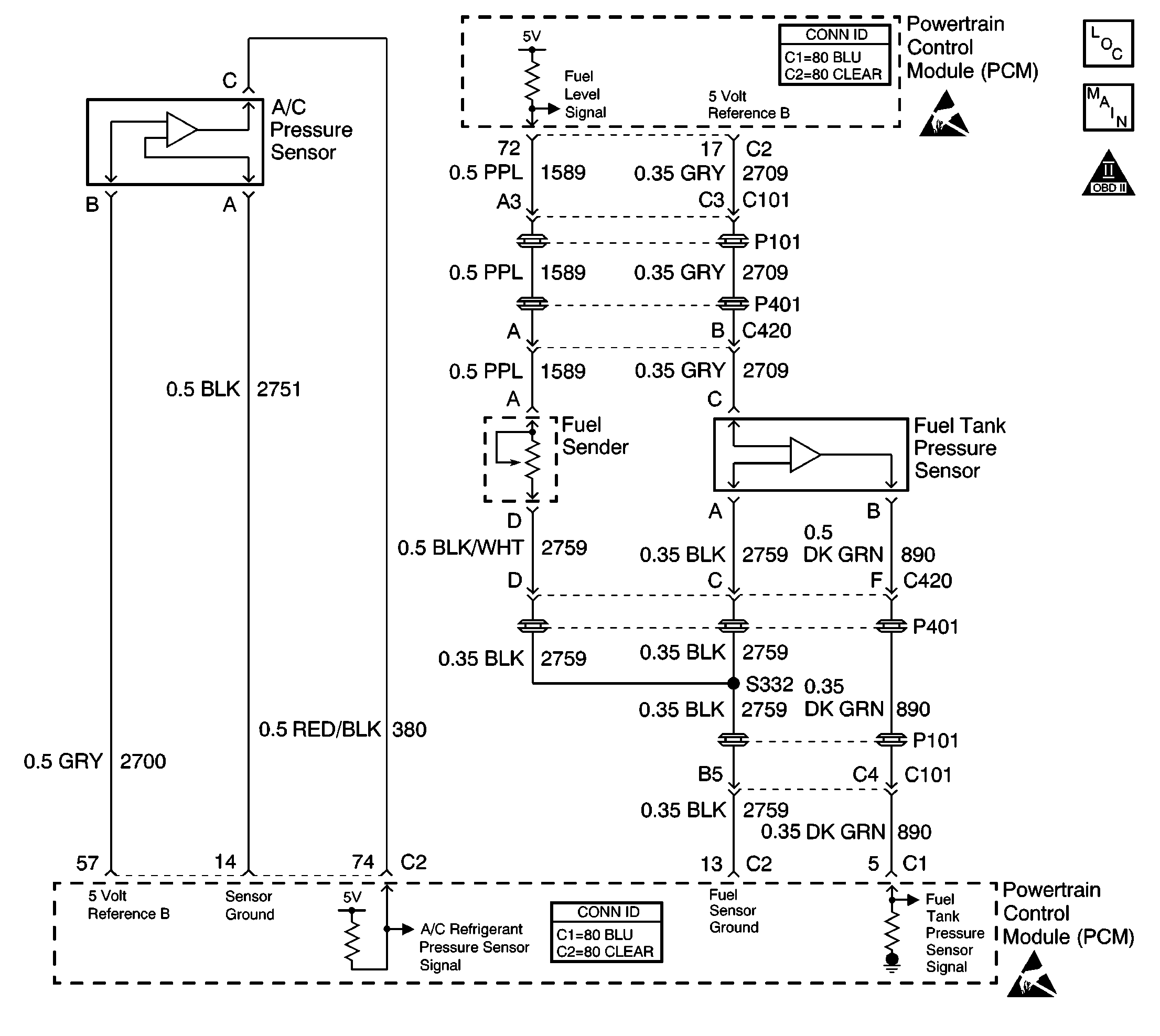
Circuit Description
The PCM uses the 5 Volt Reference B circuit to feed the A/C pressure sensor, and the fuel tank pressure sensor.
The PCM monitors the voltage on the 5 Volt Reference B circuit. If the voltage is outside an acceptable range, DTC P1639 will set.
Conditions for Running the DTC
The ignition is ON.
Conditions for Setting the DTC
| • | The PCM detects a voltage out of range condition on the 5 Volt Reference B circuit. |
| • | The condition exists for less than 1 second. |
Action Taken When the DTC Sets
| • | The PCM illuminates the malfunction indicator lamp (MIL) during the second consecutive trip in which the diagnostic test runs and fails. |
| • | The PCM stores the conditions present when the DTC set as Freeze Frame/Failure Records data. |
Conditions for Clearing the MIL/DTC
| • | The PCM will turn the MIL OFF after the third consecutive trip in which the diagnostic runs and passes. |
| • | The history DTC will clear after 40 consecutive warm-up cycles have occurred without a malfunction. |
| • | The DTC can be cleared by using the scan tool Clear DTC Information function. |
Diagnostic Aids
If the condition is intermittent, refer to Intermittent Conditions .
Test Description
The numbers below refer to the step numbers on the diagnostic table.
-
Check for a proper 5V Reference B voltage. If the DMM displays 5V with the A/C pressure sensor disconnected, a short to voltage in the A/C pressure sensor signal circuit, a shorted A/C sensor, or an internally shorted PCM could be the cause of the malfunction.
-
Determines if the 5V Reference B is shorted high or shorted low.
-
Checks for the cause of a 5V Reference B voltage more than 5 volts. If DMM displays 5 volts with the fuel tank pressure sensor disconnected, the fuel tank pressure sensor signal or the PCM could be the cause of the malfunction. If the DMM does not display 5 volts, the 5V Reference B circuit or the PCM could be the problem.
-
With the PCM disconnected, a DMM display of 0V isolates the problem to the PCM or the 5V Reference B circuit to the fuel tank pressure sensor.
-
Determines whether the PCM or the 5V Reference B circuit to the fuel tank pressure sensor is the cause of the problem.
-
Determines whether the A/C pressure sensor signal is shorted to voltage or the A/C pressure sensor is internally shorted. If the DMM does not display battery voltage, the A/C pressure sensor signal circuit and the PCM are OK.
-
Checks for an internally shorted fuel tank pressure sensor. If the DMM displays 5 volts, the fuel tank pressure sensor is the cause of the malfunction.
-
Determines whether a 5V Reference B circuit to the A/C or fuel tank pressure sensors is the cause of the malfunction. If the 5V Reference B circuits are OK, the PCM is the cause of the malfunction.
-
This vehicle is equipped with a PCM which utilizes an Electrically Erasable Programmable Read Only Memory (EEPROM). When the PCM is being replaced, the new PCM must be programmed.
Step | Action | Values | Yes | No | ||||
|---|---|---|---|---|---|---|---|---|
1 | Did you perform the Powertrain On-Board Diagnostic (OBD) System Check? | -- | ||||||
2 |
Important: Visually/physically check the PCM and engine grounds. Ensure that the grounds are clean and secure. If the condition is found, repair as necessary. Refer to Wiring Repairs in Wiring Systems. Using the scan tool, observe the Specific DTC Information for DTC P1639. Does the scan tool indicate that DTC P1639 passed? | -- | ||||||
3 |
Does the scan tool indicate that DTC P1639 passed? | -- | Go to Diagnostic Aids | |||||
Does the DMM display a voltage near the specified value? | 5V | |||||||
Does the display indicate a voltage more than the specified value? | 5V | |||||||
Does the DMM display a voltage near the specified value? | 5V | |||||||
Does the DMM display a voltage at the specified value? | 0V | |||||||
Did you find and correct the condition? | -- | |||||||
9 | Locate and repair the short to voltage in the 5V Reference B circuit to the A/C pressure sensor. Refer to Wiring Repairs in Wiring Systems. Is the action complete? | -- | -- | |||||
10 |
Did you find and correct the condition? | -- | ||||||
Does the DMM display a voltage near the specified value? | B+ | |||||||
12 |
Does the DMM display a voltage near the specified value? | B+ | ||||||
13 | Locate and repair the short to battery positive voltage in the A/C pressure sensor signal circuit. Refer to Wiring Repairs in Wiring Systems. Is the action complete? | -- | -- | |||||
Does the DMM display a voltage near the specified value? | 5V | |||||||
Did you find and correct the condition? | -- | |||||||
16 | Replace the A/C pressure sensor. Refer to Air Conditioning (A/C) Refrigerant Pressure Sensor Replacement in Heating, Ventilation and Air Conditioning. Is the action complete? | -- | -- | |||||
17 | Replace the fuel tank pressure sensor. Refer to Fuel Tank Pressure Sensor Replacement . Is the action complete? | -- | -- | |||||
|
Important: The replacement PCM must be reprogrammed. Replace the PCM. Refer to Powertrain Control Module Replacement/Programming . Is the action complete? | -- | -- | ||||||
19 |
Does the scan tool indicate that DTC P1639 passed? | -- | System OK |
